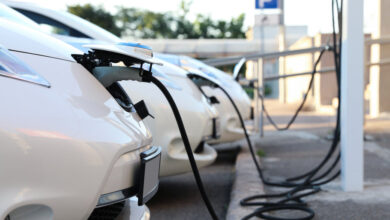Green Energy: Don’t Stick Granny with the Bill

by Planning Engineer (Russell Schussler)
Renewable energy has an equity problem. Energy policies that force consumers to incur huge costs to meet larger public aims become a hidden form of taxation. Energy bills eat up much larger proportions of income for those at the lower end of the economic scale.
When electric utilities or electric rates are used to accomplish any public good, any cost increase falls disproportionately upon those with lesser incomes and resources. Power costs tend to function as a highly regressive tax, putting the burden on those who struggle the most and having the least impact on the wealthy. As a practicing engineer I often worried what impact our projects would have on the less fortunate. Now I fear that poor struggling grandmothers will end up paying for the “green” dreams of the financially well off.
When I look at the envisioned green transition, I worry about exorbitant costs less than I used to. I’m not sure anymore what I have a sufficient understanding around the abilities of nations to incur huge amounts of costs and debt for the “public good”. It’s beyond my comprehension at times. I see so many billions spent on things that seem less consequential than the grid. So sometimes I think, why not spend that kind of big money on various assorted energy projects. Maybe we can dump huge sums of public money into longshot projects and hope for the best. But I can’t help wondering who will eventually pay for it, and hoping that poor and least able among us do not end up financing ill-considered pursuits.
This previous post summarizes what I thought I knew:
The price of energy has tremendous direct and indirect costs on society. Energy costs make up more than one-fifth of the after-tax income of America’s lowest income quintile. Higher energy costs for agriculture and manufacturing production are passed on to consumers in higher prices for products, thus lowering overall the standard of living. To the extent that energy costs are high in a region, the less economically competitive that region will be with likely correspondingly lower wages and higher unemployment.
Affordable energy provides greater comfort, health and safety while allowing machinery to improve lives and reduce drudgery. Higher energy costs limit these benefits to smaller segments of the population. Affordable energy is associated with high standards of living, improved health and better environmental protection.
But if somebody else can pay for it, maybe I’m not so concerned about the costs. For this posting, I will refrain from noting the harm “green” efforts cause irrespective of their costs and instead focus on who should pay for “green” benefits that some see as potentially attainable, whether or not such benefits ever materialize.
What I was taught
Coming up in the utility industry I was quickly disabused of any notions I might have had, that my college dreams would drive what was built as part of the power system. I wasn’t building a system for me. I was told that before making any costly decision I should think about how it might impact an elderly lady just getting buy on her pension. Sometimes the admonition was made in terms of a struggling farmer in the field. We played an important role in the lives of our consumers and their wants and needs played a central role in our decision making. The bulk of our consumers were not people buying fancy car or living lavish lifestyles. They needed a good practical power system, not something out of an engineer’s daydream.
Now don’t confuse this admonition with being cheap or focusing solely on cost. I learned if fancy works well and is also economic, that’s a great thing. But not fancy for fancy’s sake. Every decision must consider both near and long-term needs. Every decision must balance cost, reliability and public responsibility in order to benefit every user of the grid. Decisions had to support the local economies and businesses and improve the quality of life for all. I will note our concerns were often more focused on more on local considerations and less on global, than many might like today. But we were extremely serious about all environmental requirements and minimizing overall environmental impacts. I feel privileged to have been part of expanding an effective, reliable, publicly responsible grid. It is better and more wonderful than what a college kids dream’s might have been. I am at proud of my work, largely because at each step I asked myself, “What is the best thing we can do for Granny, or that farmer in the field?”
Some things I did
I don’t want anyone to get the idea that worrying about Granny served to impede the development of the grid or make planning boring. For years I worked to ensure cheap excess hydro from the Pacific northwest could flow over a state-of-the-art HVDC (High Voltage Direct Current) tie to Los Angeles to displace fossil fuel generation in the LA basin. This was part of a big hi-tech win-win project. That decision was made before my time, but it was a good one for many grannies. Later I participated in many decisions regarding the use hi-tech power electronics or other technological innovations. Many opportunities were deferred because they did not make sense for a practical grid, but eventually other major big ones were judged worthwhile. The point being you don’t just do things to do things, you do things when and where they make sense.
I won’t say that all decisions made everywhere I worked were good or adequately considered Granny. The pull of the new, of being first, or being considered a smart innovator is strong. A predecessor of mine had pushed through an energy storage generation project bolstered by some questionable assumptions. It qualified for millions in research funding. It was completed just before I took over planning. It worked ok, but had a number of problems initially. For just what we spent on the project, it would have been much better our consumers if we had installed conventional gas combustion turbines instead. Good engineering ignores sunk costs, so we used it as efficiently and effectively as possible. It was exciting to showcase a new technology. It was great to have developed a specialized expertise. But more attention should have been paid initially as to what that project might do for Granny.
Later in the 1990’s in Alabama we had an old coal plant that needed to be retired and that coupled with the expiration of some power contracts meant we needed a major generation addition. We did numerous detailed scenarios which built a big wall of computer printouts, looking at all relevant factors out over thirty years to see what was in our consumers best interests. Most not involved with the extensive studies thought the best plan would be a new coal plant as our current ones were performing well. While the future operating costs of a coal plants were projected to be low (in reality it would not have worked out that way) the initial costs of building the plant infrastructure were too high and the future too uncertain. We looked at many options including an innovative biomass switch grass burning facility. The study work showed that the best alternative was to put two new combustion turbines adjacent to the old coal plant. The waste heat from the new combustion turbines was used to heat steam to power the old coal turbines. It functioned as an efficient and clean gas combined cycle plant. For the first couple years, some were upset we had not gone with coal, but this choice was been shown to be a sound one across the ensuing years.
It’s hard to plan for the future, things keep changing. There can be so much potential variation in costs, needs, regulations and various other critical factors. But one thing we had going for us was that we understood who was being served and what the important things were that we were trying to do. Meeting regulations was a requirement, not our end goal. When regulations are overly focused too narrowly, many things outside the regulated concerns can go wrong.
Utilities have less and less decision-making power over time
Over my career, our ability to make decisions impacting the general good of our consumers became more and more constrained. In the generation area, oversight became stronger as options and alternatives became more constrained. More and more utilities were required to conduct RFPs (request for proposals) and consider outside bids. Rather than making a decision it was more like running a process and picking a winner.
On the transmission side we would set charges for power producers who wanted to connect to our grid. If parts of the grid had to be upgraded to handle their addition, we would charge them for those improvements along with interconnection costs of hooking them up. Also, since they would be using our existing network, we would also charge them a share of the costs of existing system which they would be using. The Federal Energy Commission (FERC) was very concerned about granting independent power producers (IPPs) the right to use any grid they wanted. FERC required us to interconnect with IPPs and allowed us to charge at most the greater of incremental costs or a cost based on our average system costs, but not both. Perhaps that was needed to better spur competition and openness and make it easier on newcomers. One consequence was that when a new load had high interconnection cost nobody was compensating Granny for what she had put into the system over the years.
Regulation is always done with the intent to make the utilities more responsive to the public good as or for the good of consumers. Rules and regulations, however, constrain options and choices. Specific measures may increase focus on a narrow band of the public good, but cause havoc for many broader concerns around the public good. With all the policies around “green energy” and the push to reduce CO2 emissions, it looks like nobody is worrying broadly about more general measures of the public good and specifically about Granny and many other consumers like her.
Granny and Green Energy
A green transition of the entire electric grid, is a project of scope and intensity sufficiently bold and majestic to stir the heart of any recent college graduate. Lots of great, exciting, challenging work for such noble sounding purposes. If it’s going to save the planet, who wouldn’t want to be a part of that? What costs should be spared to prevent the oceans from boiling? Looking at all the rules, regulations and subsidies which are pushing the “green” agenda, apparently not a lot of costs are being spared. I worry what efforts to quickly transform the grid might do to reliability, but it seems we may be powerless to slow the trend down. If I can’t slow this process, I would at least like to speak up for Granny.
The green transition is primarily driven by concerns over CO2 emissions and the existential crises of climate change. I am not seeking here to amplify nor quell the concerns around CO2. The points I will raise here becomes more important the greater the challenges faced in reducing CO2. I am asking everyone who views the reduction of CO2 as critically important, to thoughtfully consider who should pay for the needed reductions.
There is no getting around it, we all exhale, use energy and resources and contribute C02 into the shared environment. Individuals due to both their choices and situations have widely varying individual C02 impacts. Increasing wealth can in some ways work to reduce carbon footprints, as it enables people to make better choices, be more efficient and employ better technology. On the other hand, increased wealth leads to higher footprints when individuals fly more, particularly in private jets, command greater resources and enjoy other carbon intensive activities. Those less well-off may have simpler needs that might tend to lower their carbon footprints. On the other hand their situation may make them engage in higher carbon emitting activities due to cost considerations. For example, it may be cheaper to burn material than use cleaner electric power. Accessing, judging and evaluating CO2 footprints is complicated.
So now, let’s consider Granny who is living her life and scraping by on a fixed pension. Her life style is simple. She’s not eating a lot. She’s not buying much. She’s not traveling far. She’s living a simple life, but she likes her home cool in the summer and warm in the winter, even if she wears a sweater to keep her power bills down. Without todays’ trends she would able to buy electricity produced mostly by natural gas. Her bills would be low and her carbon footprint would still be small compared to most in this country. But today in most cases she has to subsidize solar panels on the homes of wealthier consumers. She has to help pay for green innovation that is not helping today and which may or may not have benefits in the future. The sector of the energy industry she uses, residential electricity, has a high carbon tax burden while other sectors are less burdened. We are asking a lot from her.
Energy policies that force consumers to incur huge costs to meet larger public aims become a hidden form of taxation. When energy cost is used as a tax, it is one of the most regressive taxes available, far worse than a flat tax would be. Energy bills eat up multiple times larger proportions of income for those at the lower end of the economic scale. Overtaxing the poor is not a good way to achieve public good. We should not hide public taxes in utility bills. Let’s not hold Granny accountable for her small contribution to CO2, while wealthy individuals with so many more choice options can drive cigar boats, build mansions, consume goods and travel the world shouldering so much less responsibility per unit for the CO2 they cause to be emitted.
I understand there are a lot of great things that might be done in the area of “green” energy. Before we do that, let’s look at the money, where it’s coming from and where is it going. Many privileged “do-gooders” are making a killing on concerns around CO2, despite the fact that their personal carbon footprints are through the roof. They want to limit the choices of others, while being shielded themselves from any meaningful personal inconveniences. Many, many more less well-off individuals are paying costs that are personally highly significant and even burdensome, to support questionable green endeavors.
Moving forward, let us be clear and always seek to understand where the money is coming from and where it is going. So many great “green” projects fail to live up to expectations. Let us evaluate projects after they are completed, to see whether or not they did much good before we take even more money for similar ones from consumers. It’s not enough to believe it’s a good cause, therefore all actions and effort are justified if they have some hope of meeting the goals. We need to be accountable to those who depend upon the grid and who pay for their energy needs. We should see accounting as complete as possible telling us who the winners and losers are in these “green” undertakings. But as far as I can tell, we almost never see any follow up on these grand failures. I’m afraid no one of any importance is paying enough attention to Granny.
If we must do big “green” things, let’s think about the money. I don’t know whether we should tax the wealthy, just print up money, raise corporate taxes, hit the middle class or what. I do know we shouldn’t just pass the costs on to Granny. She just needs a small amount of economic and reliable energy produced in a publicly responsible way that maybe doesn’t hold her disproportionately responsible for solving all the world’s problems.
Postscript: Poor Oma in Germany
I’m afraid the “green transition” has already done great harm to many poor German grandmothers. The German Energiewende, has been described as the “ transition by Germany to a low carbon, environmentally sound, reliable, and affordable energy supply”. Many saw Germany as a showcase for what was possible. In earlier years it has been touted as a spectacular success. Grid concerns associated with a “green” transition were often dismissed by simple declaring “What about Germany”. In 2017 I coauthored this article entitled The Myth of the German Renewable Energy Miracle. In 2019 after spending over $150 billion in Euros, Federal Court of Auditors President Kay Schuller noted that the expenditures “are in extreme disproportion to the results”. Although a lot of wind and solar were added, since then the results of the German transition appear to me more and more disappointing with time.
While Germany did add a lot of wind and solar, their efforts have not proved sustainable benefits and they are now are stymied by their own increased use of coal and oil. They changed a lot, but it was not foundational change. Germany’s past energy policies have created international repercussions. But it is sad enough just to note the impacts upon the German population. Energy poverty has been a major problem for many and it is expanding to where you now see headlines proclaiming that Energy poverty increasingly affecting Germanys middle class. In Germany and other parts of Europe we are seeing increasing problems of “Heat or Eat” (See here, here, here or just Google it).
It’s a tough situation. Who pays for that expensive failed experiment? How should Germany balance what industrial customers pay, versus what residents pay? These are challenging painful weighty decisions. If power is too expensive for businesses, the economy may be wrecked for all. But forcing the cost on those less well off is cruel. It’s much better to not go there to such an extreme and reduce the likelihood of such problems. Maybe I was correct to assume that you just can’t print up money to run costly experiments on the grid. Costs may matter after all. Let’s make sure we don’t drive our grandmothers toward ruin by unworkable technology based on overly hopeful dreams which ignore where the money will come from if they fail.




